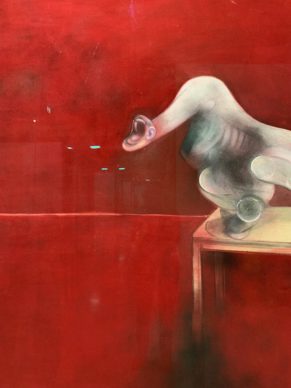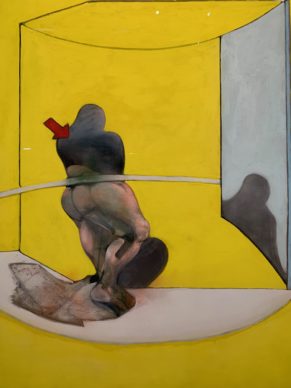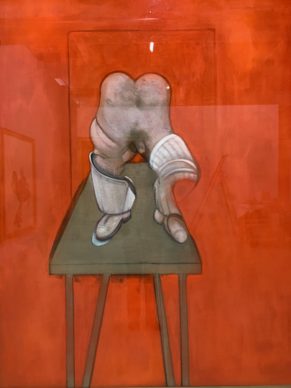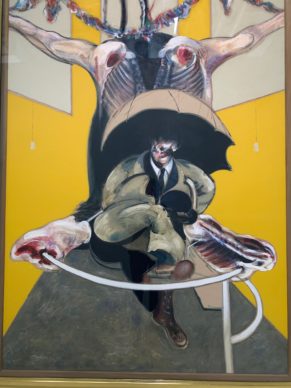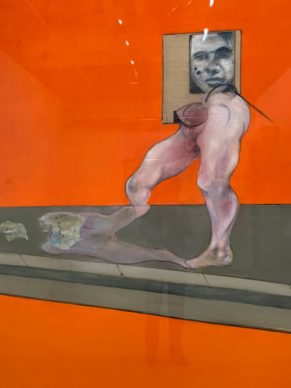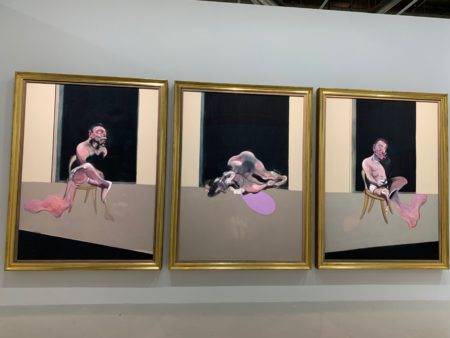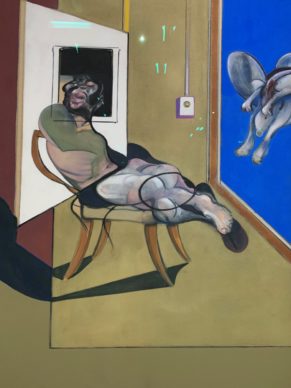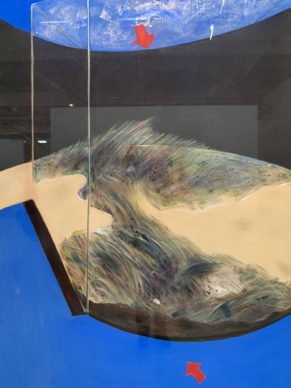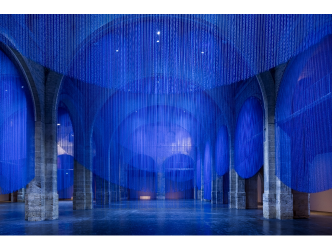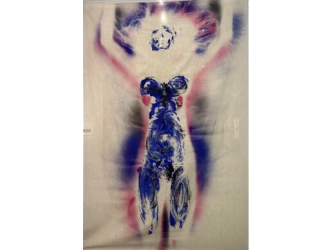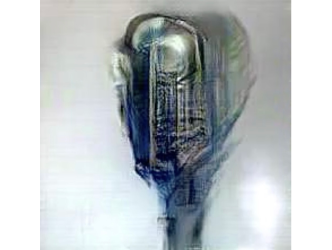Crucial days
There are crucial days that can change your life forever. Take the British painter Francis Bacon. On 26 October 1971 he was the subject of a major exhibition at the Grand Palais in Paris. Not only was it a marked success for him in Europe, accompanied by great critical acclaim, but it would also lead to the proposal of an exhibition at Moma in New York, the first show for the artist across the Atlantic.
Suicide
That same month, two days earlier in fact, Francis Bacon’s partner George Dyer took his own life at the Hôtel des Saint Pères in Paris, where he had been staying with the artist. Unsurprisingly, there’s no plaque there today to recall that crucial moment, on the wall of the hotel that is still there.
Found on a toilet bowl
But from 1971 the suicide scene would give rise to a “monument” of sorts: a triptych composed of three 2-metre-tall canvases. Bacon commented: “He was found on a toilet bowl like this one and he had vomited into the sink. If my paintings can be considered to be illustrative then this one is the closest to a narrative form.”
Centre Pompidou
This triple painting (the left-hand canvas depicts his head next to the toilet) on a mauve background is on display as part of the exhibition dedicated to Francis Bacon at the Centre Pompidou until 20 January.
50 paintings
The major theory advanced in this impactful show, comprising around fifty paintings, by the exhibition curator Didier Ottinger is that George Dyer’s death would paradoxically give birth to a calmer form of painting for Bacon, which would produce some of his best work.
Didier Ottinger
“Up until then his boyfriends had been thugs. He painted violent scenes.” The death put an end, so it would seem, to his sadomasochistic expressions.
Watch the video to find out more:
Apogee
“It was Bacon himself who described various paintings from his last 20 years as his apogee,” Ottinger remarks.
1971-1992
The curator therefore made the radical decision to devote almost the entirety of the exhibition space to works from the years spanning 1971-1992. “I wanted to kill off certain preconceived notions that the French public had about Francis Bacon.” That meant dispelling a vision of his oeuvre which was too heavily focused on blood and suffering.
3 stages
What is on view here emerges in three stages.
Power of his colours
The first and most instantaneous thing you notice is the exceptional power of the colours in his compositions. The backgrounds, which take up a lot of space, are often oranges, yellows, royal blue, carmine red… On this subject Ottinger evokes a “freedom of experimentation and a lust for life”. There is also the visible influence of one of his first jobs: as a decorator.
Influence of Picasso
The second thing you see, which is very noticeable, is the influence of Pablo Picasso. Bacon came into contact with the Spanish painter’s work for the first time in 1927, at the Rosenberg gallery while he was staying in Paris.
Surrealism
“Picasso’s works from 1926-1930, his surrealist years with those isolated figures on beaches. It triggered me to want to be a painter. I thought, why don’t I try it myself?” In a strange resurgence of surrealism, Bacon convulses, dilutes and carves up bodies to home in on the parts that interest him.
The importance of Literature
Lastly, in a very French spirit, Didier Ottinger examines the importance of literature in Bacon’s work. Six rooms are dedicated to recordings of texts in English and French by Aeschylus, Nietzsche, Bataille, Leiris, Conrad and Eliot.
A writer as a stimulant
“What the great writers produced is its own kind of stimulant. Reading them can make me want to create something myself; it’s a kind of excitement, perhaps even a sexual excitement,” said the artist.
Last canvas
The last canvas Francis Bacon made, which is also the last in this exhibition, depicts a bull in black and white against a beige background from 1991. Its subject matter – when looked at up close – is also composed of layers of dust that make the image blurred and the animal look as though it’s in motion.
Michel Leiris
His friend, the writer Michel Leiris, described the bull as “catastrophe, a kind of monster with a foreign body which seems to go against all the rules…”
Bacon as a bull
Bacon was a bull in his own genre, and this painting is perhaps his last self-portrait.
Many self-portraits
When asked why he painted himself so often he answered, “I’ve done a lot of self-portraits, really because people have been dying around me like flies and I’ve nobody else left to paint but myself.” Like a fly, or like a bull…
Until 20 January. www.centrepompidou.fr
All quotations are taken from the French catalogues (and translated into English) for the Bacon exhibitions from 2019 and 1996 at the Centre Pompidou
Support independent news on art.
Your contribution : Make a monthly commitment to support JB Reports or a one off contribution as and when you feel like it. Choose the option that suits you best.
Need to cancel a recurring donation? Please go here.
The donation is considered to be a subscription for a fee set by the donor and for a duration also set by the donor.


